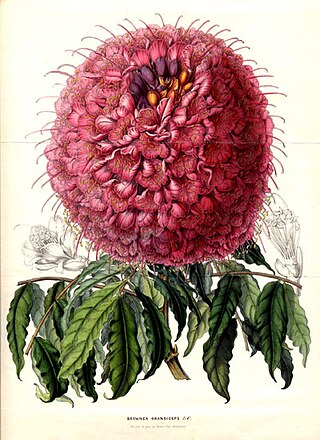
Chrysophyllum is a group of trees in the Sapotaceae described as a genus by Linnaeus in 1753.

Cynometra is genus of tropical forest trees with a pantropical distribution.

The subfamily Detarioideae is one of the subdivisions of the plant family Fabaceae (legumes). This subfamily includes many tropical trees, some of which are used for timber or have ecological importance. The subfamily consists of 84 genera, most of which are native to Africa and Asia. Pride of Burma and tamarind are two of the most notable species in Detarioideae. It has the following clade-based definition:
The most inclusive crown clade containing Goniorrhachis marginataTaub. and Aphanocalyx cynometroidesOliv., but not Cercis canadensisL., Duparquetia orchidaceaBaill., or Bobgunnia fistuloides(Harms) J. H. Kirkbr. & Wiersema.

Dialium is a genus of flowering plants in the family Fabaceae, subfamily Dialioideae. Velvet tamarind is a common name for several species. The genus includes 37 species which range from the tropical Americas to sub-Saharan Africa, Madagascar, India, Indochina, and western Malesia.

Didelotia is a genus of flowering plants in the family Fabaceae. It includes 13 species native to western and west-central tropical Africa, ranging from Sierra Leone to the Democratic Republic of the Congo.
Englerodendron is a small genus of legumes belonging to the family Fabaceae, that are native to tropical Africa.

Gilbertiodendron is a genus of legume in the family Fabaceae. It consists of about 25 species of tree native to west and west-central tropical Africa. Members of this genus were formerly considered to be in the genus Macrolobium but that genus is now restricted to species growing in tropical America. It is closely related to Pellegriniodendron.

Hymenostegia is a genus of flowering plants in the family Fabaceae. It includes 14 species native to west and west-central tropical Africa.

Julbernardia is a genus of plants in the family Fabaceae. It includes ten species native to tropical Africa, ranging from Nigeria to Kenya, Mozambique, Botswana, Zambia and Namibia. They are medium-sized trees.
Loesenera is a genus of plants in the family Fabaceae. It includes four species of trees or shrubs native to west and west-central Africa, including Liberia, Côte d'Ivoire, Nigeria, Cameroon, Gabon, and Republic of the Congo. Its habitat is tropical lowland rain forest, typically along river banks and in swampy areas.

Schefflerodendron is a genus of flowering plants in the family Fabaceae. It includes four species of trees native to tropical Africa, ranging from Cameroon to Tanzania and Angola. They grow in tropical rain forest and seasonally-dry forest, including disturbed areas. Three species are native to the Guineo-Congolian forests of west-central Africa, and one species also extends to the Zanzibar-Inhambane coastal forests of Tanzania.

Newtonia is a genus of flowering plants in the legume family, Fabaceae. It includes 16 species of trees native to sub-Saharan Africa. It belongs to subfamily Caesalpinioideae and the Mimosoid clade or tribe. The genus is known from the early Miocene of Ethiopia based on compressions of its diagnostic, winged seeds.
Gluema is a genus of plant in family Sapotaceae described as a genus in 1935.
Aphanocalyx is a genus of flowering plants in the family Fabaceae. It belongs to the subfamily Detarioideae. It includes 14 species native to tropical Africa, ranging from Sierra Leone to Côte d'Ivoire, and from Cameroon to Angola and Tanzania.
Pseudoprosopis is a genus of flowering plants in the family Fabaceae. It includes seven species of shrubs, lianas, or small trees native to tropical Africa. Typical habitats include tropical rain forest, gallery forest, seasonally-dry forest, and dense thicket. Three species are native to west-central Africa, two species to West Africa, and two species to southeastern Africa – one to the Zambezian region and one to the Zanzibar–Inhambane region. The genus belongs to the mimosoid clade of subfamily Caesalpinioideae.
André Aubréville was a French botanist, professor at the National Museum of Natural History in Paris and a member of the Academy of Sciences. He was the first scientist to introduce the term "desertification" (in his 1949 book: Climats, forêts et désertification de l'Afrique tropicale, and wrote a number of floras of former French colonies.

Annonoideae is a subfamily of plants in the family Annonaceae, with genera distributed in tropical areas world-wide. The family and this subfamily are based on the type genus Annona.
Gambeya is a genus of flowering plants belonging to the family Sapotaceae.
Salacighia is a genus of flowering plants belonging to the family Celastraceae.
Pterorhachis is a genus of flowering plants belonging to the family Meliaceae.










